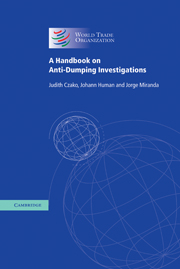PART III - INJURY AND CAUSATION DETERMINATION
Published online by Cambridge University Press: 05 March 2012
Summary
INTRODUCTION
The AD Agreement provides more specific guidance relating to dumping calculations than it does with respect to the evaluation of injury and causation in anti-dumping investigations. Nonetheless, Article 3 does make it clear that the investigating authorities must address certain factors in conducting their injury analyses. However, the AD Agreement places fewer restrictions on the methods of analysis, sources of information, time periods, and other elements of the analysis of injury and causation. Thus, there may be great variation in specific practices from one Member to another in analyzing injury and causation, while still remaining consistent with the applicable provisions of the AD Agreement.
Part III focuses on the injury phase of the investigation leading to the issuance of a final affirmative or negative injury determination. As stated in Part I, some Members conduct bifurcated anti-dumping investigations, in which one government agency or ministry performs the dumping margin calculations and makes the dumping determination, while a separate agency or ministry gathers the relevant information, conducts the analyses and makes the determinations relating to injury and causation. Other Members conduct dumping investigations in which determinations relating both to dumping and injury are made by the same agency or ministry.
Regardless of what organization and analytical structure is applicable, Article VI of the GATT 1994 and the AD Agreement require findings of dumping, injury and a causal link before anti-dumping duties may be imposed. Many of the specific steps leading up to the initiation of an anti-dumping investigation that are set forth in detail in Part I are also relevant to the injury phase.
- Type
- Chapter
- Information
- A Handbook on Anti-Dumping Investigations , pp. 225 - 376Publisher: Cambridge University PressPrint publication year: 2003



